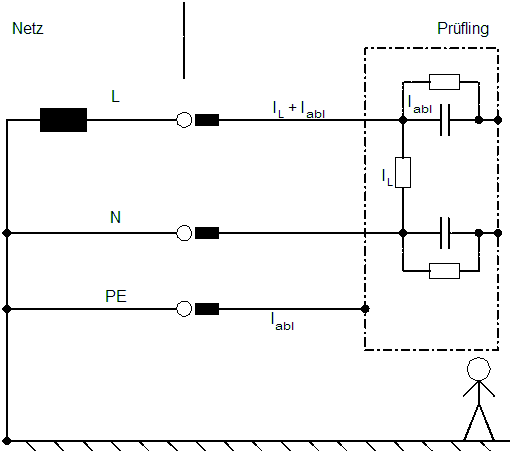Test Method
Leakage current

A leakage-current test can be performed at devices of protection class I and protection class II. It is used to check, whether the leakage current going through the insulation is below a certain limit value determined by standards. The test is performed at components, machines, devices and systems according to a great variety of national and international standards.
To determine the leakage current, the DUT is normally operated with nominal voltage +10%.
The testing device selects a standardized measuring circuit matching the required testing standard.
At devices of protection class I, you can measure the ground-leakage current in the protective conductor.
At devices of protection class I and II, the enclosure-leakage current can be detected at accessible parts by means of a test probe.
At electro-medical products, you can perform all tests required by standard EN60601 and other international standards.

The picture shows a typical application of a DUT connected to the power supply. The largest part of the current flows through the load (Il) and the leakage current (Ilkc) flows through various insulation resistors to the enclosure of the DUT, from where it is discharged against ground.
In the event of an error, you have a high-impedance or even interrupted discharge, which leads to dangerous touch currents.

For leakage-current tests, it is important to detect currents of both, the L-conductor and the N-conductor, because they can have different levels. SCHLEICH testers normally perform these tests automatically. The currents can be evaluated individually or jointly.
Please note that leakage currents can change in the course of time, which applies particularly to heat-generating products.
Products offered by SCHLEICH:
- single testers
- combination testers (combination with safety or function tests)
- measuring circuits for various standards
- peak-value detector up to 1 MHz
- medical leakage-current test
- manual testing with test probes
- fully-automatic testing
- a variety of test probes
- various device families
Standards commitees

For legal reasons, we can often not make a binding statement about the test conditions. For the application, the currently valid standards for testing your product apply.
Depending on the geographical location of the product, the standards to be applied can vary. For further information, please also refer to the below-mentioned bodies.
![]()
![]()
![]()
![]()
![]()

